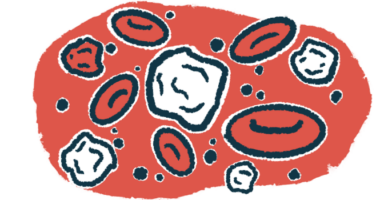Study finds possible diagnostic biomarkers for idiopathic PAH
Protein inhibitor could be used in therapy, researchers say

Researchers identified two genes — PRDX1 and TNFAIP3 — whose activity levels could serve as diagnostic biomarkers for idiopathic pulmonary arterial hypertension (PAH).
The genes are related to ferroptosis, an iron-dependent type of cell death involved in lung diseases and previously associated with PAH.
“Our comprehensive analysis explored potential ferroptosis-related biomarkers and therapeutic targets in IPAH, offering valuable insights into its complex [disease processes] and presenting novel diagnostic and therapeutic avenues,” the researchers wrote.
The team identified ustekinumab — an inhibitor of TNFAIP3, a protein involved in the regulation of the immune system and inflammation — as a potential therapeutic approach.
The study, “Integrated bioinformatics identifies ferroptosis biomarkers and therapeutic targets in idiopathic pulmonary arterial hypertension,” was published in Scientific Reports.
Exploring genes and immune mechanisms
PAH is caused by the narrowing of the pulmonary arteries (the blood vessels that carry blood to the lungs) driven by vascular remodeling, or structural alterations, due to excessive growth of smooth muscle cells. This increases blood pressure and makes it harder for the heart to pump blood through the lungs, eventually leading to right heart failure.
The disease can result from any of several causes, or for no apparent reason — in which case it’s called idiopathic PAH (IPAH). Iron deficiency is common in people with IPAH.
The researchers hypothesized that ferroptosis-related genes could be involved in the immune mechanisms underlying PAH and help predict the disease prognosis. They extracted data from the Gene Expression Omnibus database, a repository for large-scale expression data, and the FerrDb database, which is dedicated to ferroptosis regulators, including genes and substances, and ferroptosis-disease associations.
Genes were identified in the GSE48149 database, which included eight IPAH and nine healthy lung tissue samples, and crossed with FerrDb to identify differentially expressed genes. A total of 27 ferroptosis-related genes were identified, of which 15 showed lower activity in people with IPAH and 12 that were expressed at higher levels in these patients.
To identify genes capable of distinguishing patients with IPAH from healthy individuals, the researchers used two machine learning algorithms. Machine learning is a type of artificial intelligence in which computers detect patterns in data sets and then make predictions.
Six genes — KEAP1, TNFAIP3, MEG3, NFS1, PRDX1, and BEX1 — were identified by both models aimed at helping to diagnose IPAH. Further analysis of IPAH tissues revealed decreased activity levels of KEAP1 and PRDX1, and increased activity of BEX1, MEG3, NFS1, and TNFAIP3, compared with healthy tissues.
These genes were associated with the regulation of cell growth and division, modulation of immune responses, and vascular smooth muscle contraction. This indicates their potential involvement in IPAH development, according to the scientists.
To confirm the activity patterns of the marker genes, the team validated the results across independent data sets.
Results were generally consistent among data sets, with one exception: The one that analyzed gene activity in immune cells presented different expression patterns for the KEAP1, PRDAX1, and TNFAIP3 genes. The researchers suggested that PRDX1 was associated with endothelial cell dysfunction and TNFAIP3 with immune responses, serving as a potential diagnostic marker for IPAH. Endothelial cells line the inside of blood vessels.
The researchers used the Drug Gene Interaction Database to predict drugs that would interact with the marker genes. That identified ustekinumab, which is used to treat immune-mediated inflammatory diseases.
“These findings propose PRDX1 and TNFAIP3 for future use in predictive diagnostics, prevention, patient stratification, and [ustekinumab] as the personalized medicine for IPAH,” the researchers wrote. “Nevertheless, further research must be conducted to validate potential drug targets for clinical applicability.”








